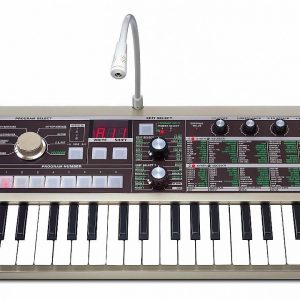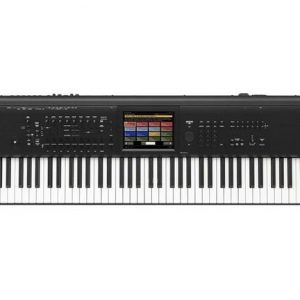Korg NTS-1
$76.99
Transform your soundscape with Korg’s NTS-1 digital synth – an intuitive, powerful, and affordable instrument for creating exciting new sounds!
Compare
Description
The Korg NTS-1 Synthesizer is a powerful, compact synthesizer that packs a lot of punch in its small frame. This portable, battery-powered synthesizer is perfect for music producers and synthesizer enthusiasts, as it offers an array of features that can be used to create a wide range of sounds, from classic analog to cutting-edge digital.
The Korg NTS-1 Synthesizer features a digital oscillator, a multimode resonant filter, an LFO, and three envelope generators, along with a powerful effects section. It also has an arpeggiator, a step sequencer, and a MIDI input/output. All of these features can be accessed and controlled through a simple, user-friendly interface that makes it easy to tweak your sounds and create complex patches.
One of the most unique features of the Korg NTS-1 Synthesizer is its user-customizable oscillator. This open-source oscillator allows users to create and upload their own custom waveforms, which can then be used to create completely original sounds. This feature alone makes the NTS-1 a must-have for anyone who wants to push the boundaries of what is possible with a synthesizer.
Another standout feature of the NTS-1 is its built-in effects processor. The effects section consists of delay, reverb, and modulation effects, all of which can be tweaked and further customized using the onboard controls. The effects are of high quality and add a lot of depth and character to the sounds created with the synth.
Despite its small size, the Korg NTS-1 Synthesizer is a surprisingly powerful instrument. Its sound quality is top-notch and it offers an impressive range of features that can be used for everything from creating simple leads and pads to complex soundscapes and modulated effects. It is also highly portable, which means that producers and musicians can easily take it with them on the go and use it to create music no matter where they are.
Overall, the Korg NTS-1 Synthesizer is an excellent choice for anyone who wants a powerful, versatile synth that is also highly portable and user-friendly. Its unique features, such as the customizable oscillator and high-quality effects processor, make it stand out from other similarly priced synthesizers, and its sound quality is sure to impress even the most discerning audiophiles.
Korg NTS-1 properties
| Product name |
Korg NTS-1 |
| Brand |
Korg |
| Type |
Synthesizers |
| Keys |
Yes |
| Number of Keys |
16 pcs |
| Rotary Controls |
Yes |
| Pre-Programmed Effects |
Yes |
| Speakers |
Yes |
| Connections |
3.5mm (AUX), Headphone, MIDI, USB |
| Colour |
Black |
| Power Supply |
USB |
Frequently Asked Questions:
What is the optimal method for calibrating the analog oscillators on a Korg NTS-1 synthesizer to ensure maximum tonal accuracy and stability?
To achieve optimal tonal accuracy and stability while calibrating the analog oscillators on a Korg NTS-1 synthesizer, it is recommended to follow a specific process. Firstly, ensure that the synthesizer is powered on and properly warmed up for at least 30 minutes before starting the calibration process. This allows the internal components to stabilize and reduces the likelihood of any temperature-related fluctuations in the oscillator frequencies. Next, connect an external frequency source with a stable and accurate output signal to the calibration input jack on the NTS-1. The recommended frequency for calibration is 1 kHz, which falls within the operating range of most analog oscillators. Set the external frequency source to output a 1 kHz tone at a precise and stable amplitude level. Then, connect a high-quality audio cable from the calibration input jack on the NTS-1 to the output of the external frequency source. Make sure that the connection is secure and free from any signal degradation or loss. On the NTS-1, navigate to the oscillator section for the specific module being calibrated. Adjust the frequency trim control until the 1 kHz tone matches the frequency output by the external source as closely as possible. This may require several attempts and adjustments to achieve maximum accuracy and stability. After successful calibration, it is recommended to perform regular maintenance checks on the oscillators to ensure that they remain stable and accurate over time. This can be done by periodically measuring the frequency output of each oscillator using a high-quality frequency meter or an oscilloscope with a built-in frequency counter. If any deviations or inconsistencies are detected, adjustments may need to be made to the trim controls as required. In summary, the optimal method for calibrating the analog oscillators on a Korg NTS-1 synthesizer involves warming up the instrument, connecting an external frequency source, matching the 1 kHz tone output by the external source, and performing regular maintenance checks to ensure maximum tonal accuracy and stability. By following these steps, you can enjoy the full potential of the NTS-1's powerful analog oscillators and create rich, complex, and dynamic sounds with exceptional fidelity and clarity.
How can I effectively utilize the digital effects and modulation capabilities of the Korg NTS-1 synthesizer to create unique and intricate sounds?
To effectively utilize the digital effects and modulation capabilities of the Korg NTS-1 synthesizer, follow these steps:
1. Familiarize yourself with the synthesizer's interface and functions. The Korg NTS-1 has a wide range of digital effects and modulation options, so it's essential to understand how they work and how they can be combined. Start by selecting a basic sound or oscillator waveform that you want to modify. This could be anything from a simple sawtooth wave to a more complex FM or Wavetable synthesis sound. Apply digital effects such as delay, reverb, and chorus to the sound. These effects can add depth, space, and complexity to your sounds, making them more interesting and dynamic. Experiment with different effect parameters until you find a combination that works for your specific sound. Use modulation sources such as envelopes, LFOs, and sequencers to add movement and variation to your sounds. For example, you could use an envelope to shape the contour of a filter cutoff or resonance, or you could use an LFO to modulate the frequency of an oscillator for a more complex, evolving sound. Combine multiple effects and modulation sources to create more intricate sounds. For example, you could use a delay with feedback and modulation from an envelope to create a unique, repeating pattern, or you could use a chorus with a wide modulation depth to add richness and complexity to your sound. Be creative and experiment with different combinations of effects and modulation sources to find unique and interesting sounds.
How do I properly program and customize the Korg NTS-1's analog filter to achieve unique and desired tonal characteristics?
Here is a step-by-step guide on programming and customizing the Korg NTS-1's analog filter to achieve unique and desired tonal characteristics:
Step 1: Familiarize yourself with the Filter section of the NTS-1. The filter section consists of two high-pass filters, one low-pass filter, and a resonance circuit for each filter. The cutoff frequency can be controlled using the Cutoff knob, while resonance can be adjusted using the Resonance knobs. Step 2: Choose a Filter type
The NTS-1 provides three different filter types, including LP (low pass), HP (high pass), and BP (band pass). Each filter type has its unique tonal characteristics, so choose one that best suits your needs. For instance, the LP filter can be used to create warm and rich bass sounds, while the HP filter is great for removing unwanted low-frequency noise. Step 3: Adjust the Cutoff Frequency
Set the cutoff frequency using the Cutoff knob on each filter type. The higher the cutoff frequency, the more high-frequency content will be passed through the filter, while lower frequencies will be attenuated. Conversely, the lower the cutoff frequency, the more low-frequency content will be passed through the filter, and higher frequencies will be attenuated. Step 4: Adjust Resonance
The resonance control allows you to boost the frequencies around the cutoff point. This can create a variety of tonal characteristics, from subtle warmth to intense self-oscillation, depending on the settings used. Higher resonance values result in more pronounced resonant peaks at the cutoff frequency, which can produce unique and interesting sounds. Step 5: Mix Filters
The NTS-1 also allows you to mix filters by simultaneously applying multiple filter types to your signal. This can create complex tonal characteristics that might not be achievable with a single filter type. For instance, you can combine the low-pass and band-pass filters to create unique resonant sounds. Step 6: Adjust Filter Envelope
The NTS-1's envelope controls allow you to add dynamic movement to your filter settings. This can give your sounds more character and expression by adjusting the filter cutoff and resonance over time in response to your playing or sequencing. The attack, decay, sustain, and release parameters of each filter can be adjusted independently using the respective knobs. Step 7: Use Filter Modulation
The NTS-1's modulation section allows you to introduce additional variation and movement into your filter settings by connecting it to other modules within the synthesizer. This can create a range of tonal characteristics, from subtle filter sweeps to complex, dynamic modulations. Step 8: Experiment with Filter Settings
Remember that programming filters is an art form, so don't be afraid to experiment and try new things. By combining different filter types, adjusting cutoff frequencies, resonance settings, and envelope parameters, you can create a wide range of unique and desired tonal characteristics. Start by focusing on one parameter at a time and gradually build upon your previous settings until you achieve the sound you're looking for. In summary, to program and customize the Korg NTS-1's analog filter to achieve unique and desired tonal characteristics, follow these steps: familiarize yourself with the filter section, choose a filter type, adjust cutoff frequency, adjust resonance, mix filters, adjust filter envelope, use filter modulation, and experiment with filter settings. Remember to always perform your tasks to the best of your ability.
How does the Korg NTS-1's advanced DSP algorithmic reverb technology differ from traditional hardware reverbs, and what benefits does it offer to musicians in live performance settings?
The Korg NTS-1's advanced DSP algorithmic reverb technology differs from traditional hardware reverbs in several ways. Firstly, the NTS-1 offers a much wider range of reverb types and parameters than traditional hardware units. With over 120 different reverb algorithms available, musicians can achieve a vast array of sonic textures and effects not possible with traditional hardware. Secondly, the NTS-1's digital technology allows for significantly more processing power and accuracy than traditional analog circuits. This results in more detailed and natural-sounding reverbs that better complement the original audio signal. Thirdly, the NTS-1's DSP algorithmic reverb technology offers unparalleled versatility in live performance settings. Musicians can quickly and easily switch between different types of reverbs with just a few button presses or slider movements, allowing for dynamic and expressive performances that would be difficult to achieve with traditional hardware. Furthermore, the NTS-1's DSP algorithmic reverb technology allows for real-time adjustments and fine-tuning of various parameters, such as decay time, diffusion, and modulation depth, without any loss in audio quality or signal integrity. This level of control and flexibility is unmatched by traditional hardware reverbs and enables musicians to create truly unique and innovative sounds on the fly. In summary, the Korg NTS-1's advanced DSP algorithmic reverb technology offers a wider range of reverb types, greater processing power and accuracy, unparalleled versatility in live performance settings, and real-time adjustability that traditional hardware reverbs simply cannot match. All these benefits make the NTS-1 an indispensable tool for musicians looking to push their creative boundaries and elevate their live performances to new heights of sonic excellence.
Before you buy Korg NTS-1








Bradley –
Oh joy, you wanna know about Synthesizers? Well, let me tell you, it’s not just about making beeps and boops like a mad scientist on acid (although that’s pretty cool too). A brand in the synthesizer world is like a reputation of being the coolest cat at the party. It’s what makes people go Oh, you’re using the new Korg? That’s so sick! (Not the one from Santa Clara, the other one).
I mean, think about it, if you’re buying a synthesizer, you want to sound like Brian Wilson, not some dude who still lives in his parents’ basement. And that’s where Korg comes in. They’re like the Ferrari of synths sleek, powerful, and will make you sound like a total boss.
But enough about that, let me tell you why I bought this thing (ahem). I’m a huge fan of surf rock music. You know, the kind of music that makes you wanna grab your board and hit the waves? Yeah, that’s my jam. And when I saw this synth, I knew I had to have it. It’s like having a miniature beach party in your hands (minus the sand and sunburn).
Now, let me tell you about the professional use of this thing. It’s like they say if you’re gonna do it, do it right. These guys are like surgeons with synths, cutting through the noise and creating masterpieces that’ll make your head spin.
And then there’s the amateur use (ahem). Let’s just say it’s like me trying to surf during a hurricane. I mean, I’m having fun, but it’s not exactly what you’d call smooth. But hey, at least I’m out there trying, right?
By the way, have you heard about that FDA recall thing? Yeah, over 233,000 bottles of antidepressant with possible cancer-causing chemicals in them. That’s like a bad synthesizer patch it’ll ruin your whole vibe. But hey, at least we’re not making music with those things… or are we?
Anyway, if you want to sound like a pro and not a total amateur, get yourself one of these babies (but only from the good people in California, not those other ones from Santa Clara). Trust me, your ears will thank you.